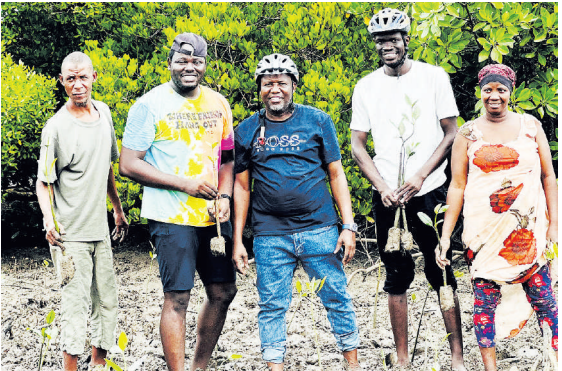

For many years, Mombasa has struggled against the environmental crises threatening the coastal city —extreme heat, urban flooding and rising mountains of waste.
“The issue of extreme heat has been normalised. People here believe it’s just the way things are,” Basil Angaga, the head of sustainability in the Mombasa environment department said as we began our interview.
A few minutes into our conversation, a power blackout hits his office at the Mombasa county environmental premises.
The air-conditioning shuts off and opening the door provides no relief.
We are sweltering in the heat, a stark confirmation of how unbearable Mombasa’s temperatures have become. Though he grew up by Lake Victoria, Angaga’s path led him to Mombasa, where the ocean became his inspiration and responsibility.
Mombasa reminded him of Kisumu–water, commerce and community deeply intertwined. In Mombasa, however, he confronted an escalating crisis of severe flooding, poor waste management and extreme urban heat.
Angaga’s work spans climate resilience, waste management, energy solutions and urban planning–progress in each initiative a step toward a more sustainable Mombasa.
URBAN HEAT CRISIS
For the past three months, Mombasa’s daily temperature has averaged 30°C, with high humidity, affecting people’s productivity.
Rising temperatures have made the city unbearably hot, particularly in informal settlements where concrete and metal structures trap heat.
Walking through Mombasa, Angaga often encounters families sleeping outside late into the night, hoping for a slight drop in temperature and escaping the stifling indoor heat.
“People say Mombasa is naturally hot, but extreme heat is not something we should accept as normal. It’s affecting our health, our productivity and our way of life,” he said.
The answer to the Urban Heat Island (UHI) effect lies in greening the city, Angaga said. UHIs are caused by the way urban environments absorb and retain heat.
Buildings, roads and other infrastructure absorb solar radiation during the day. They release the heat slowly at night, leading to higher temperatures compared to natural landscapes like forests and fields.
“Our solid concrete and steel homes have become unintended ovens. The hot months make indoor spaces unbearable,” he said.
To combat this crisis, Angaga co-founded Together for Climate (T4C), a community-based organisation championing increased tree cover in urban areas.
“Mombasa has limited green spaces, but we must rethink our cityscape. Instead of ornamental flowers along road medians, why not plant indigenous trees that provide shade and reduce temperatures?” he asked.
“We need to redesign our urban spaces to make them livable again.”
Angaga said urban areas must adopt nature-based solutions that absorb heat and create cooling islands. He emphasised that roundabouts, medians and sidewalks present opportunities to lower urban heat.
“Currently, most urban landscaping relies on exotic plants with aesthetic value but poor heat mitigation properties,” he explained.
“Exotic plants often require heavy watering to survive and many wilt during dry months. We must shift toward indigenous trees and shrubs that not only thrive in our climate but also provide effective cooling.”
African shade trees and shrubs, Angaga said, have a remarkable ability to withstand extreme heat while enhancing the environment.
“Urban greenery isn’t a luxury reserved for wealthy suburbs–it should be integrated into everyday spaces, including streets, malls, parking lots, schools, hospitals and markets,” he said.
“By expanding urban green spaces, we can collectively cool the city and counteract the urban heat island effect.”
FLOOD CRISIS
Unchecked urbanisation and poor drainage have also led to perennial flooding.
“The city is drowning under the weight of concrete. We’ve built over natural drainage systems and now when the rains come, there’s nowhere for the water to go,” Angaga said.
Determined to address this, he spearheaded the Mombasa Flood Management Strategy in collaboration with GIZ, the German government development agency and the Covenant of Mayors in sub-Saharan Africa.
The strategy emphasises nature-based solutions, improved drainage and early warning systems to prevent disasters.
“Flooding is not just an inconvenience – it’s a public health and economic crisis. We need sustainable urban planning that respects our natural waterways,” Angaga said.
BURIED IN GARBAGE
Another pressing issue is Mombasa’s mounting garbage problem. Poor waste disposal practices have turned streets into dumping grounds, blocking drainage systems and worsening the flood crisis.
Illegal dumping in the ocean also poses a significant environmental threat, endangering marine life and the fishing industry.
“Mombasa generates thousands of tonnes of waste daily, yet we’re still struggling with proper disposal and recycling,” Angaga said.
He is pushing for better waste separation at the source, enhanced recycling programmes and public awareness campaigns.
His advocacy extends to policy, urging stronger enforcement of waste management regulations to hold polluters accountable.
VOICE FOR CHANGE
Angaga’s work has gained global recognition. As the co-chair of the Cities of the Ocean platform under Unesco’s Intergovernmental Oceanographic Commission, he brings city leaders and scientists together to bridge the gap between ocean science and practical community solutions.
His expertise in climate resilience and sustainable urban planning has earned him invitations to international forums, where he advocates for policies protecting people and the planet.
Despite his global engagements, Angaga remains committed to local impact. He said sustainability isn’t just about policies–it’s about people.
That’s why he invests in the next generation through leadership training for young Kenyans, shaping future leaders who will drive meaningful change.
GREENER, COOLER, CLEANER FUTURE
For Angaga, sustainability isn’t a distant ideal; it’s an urgent necessity. His vision for Mombasa is a city that uses its natural resources responsibly–flooding is managed, waste is minimised, green cover is nurtured, and people coexist with nature, rather than battle against it.
“We have the solutions. Now, we
just need to implement them and
that requires collective effort starting
from government, the private sector
and the community,” the environment expert said.









